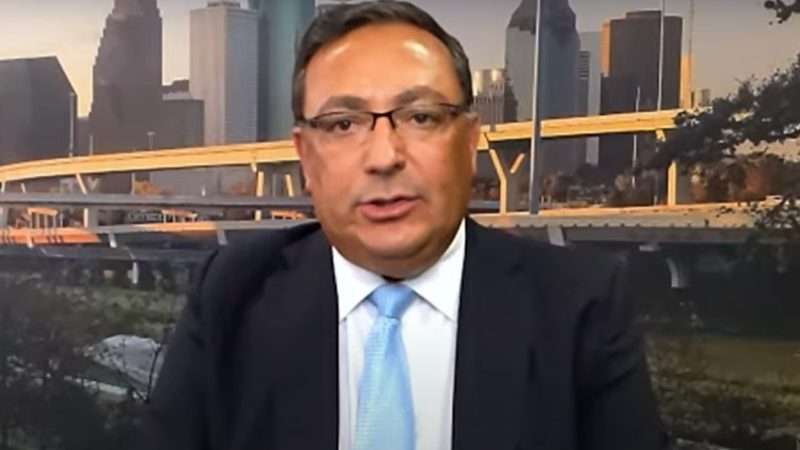During a panel discussion led by Joe Biden at the Democratic National Convention on Monday night, Houston Police Chief Art Acevedo emphasized the need for “national standards” to prevent the sort of abuse that led to George Floyd’s death in Minneapolis on May 25. “This is a watershed moment, and we can’t lose this moment,” Acevedo said. “We have got to have action at the national level. We have got to have congressional action.”
Acevedo’s passing of the buck to Congress was unsurprising, given the deadly corruption in his own department, which he was reluctant to acknowledge and slow to address. But policing is primarily a local responsibility, and Acevedo should not get away with shifting the focus from his own manifest failures by calling on the federal government to intervene.
In recent months, Acevedo, who is president of the Major Cities Chiefs Association, has been presenting himself as an avatar of police reform, joining Black Lives Matter protesters in condemning racism and expressing outrage at Floyd’s death. “We will march as a department with everybody in this community,” he told local demonstrators in May. “I will march until I can’t stand no more.” But Acevedo’s response to a deadly 2019 drug raid shows a different sort of police chief, one who reflexively defends his officers when their actions have lethal consequences, credulously accepts their version of events, and denies the existence of a systemic problem even when their lies are revealed.
The operation that killed Dennis Tuttle and Rhogena Nicholas in their home on Harding Street does not fit the usual Black Lives Matter template. Tuttle and Nicholas were white, while Gerald Goines, the veteran narcotics officer who instigated the no-knock raid based on a heroin sale that never happened, is black. The incident nevertheless illustrates the same basic problems as a case that has figured prominently in the nationwide protests triggered by Floyd’s death: the shooting of Breonna Taylor, a black EMT and aspiring nurse, in Louisville, Kentucky, last March.
In both cases, police obtained no-knock warrants based on dubious evidence, broke into homes when the residents were asleep, responded with overwhelming force when their victims tried to defend themselves, and found no evidence of drug dealing. And in both cases, there was no body camera video to show what happened.
Acevedo’s initial response to the Harding Street raid was telling. Although it was clear right away that something had gone horribly wrong, he repeatedly praised the officers as “heroes,” uncritically regurgitated their account, and posthumously tarred Tuttle and Nicholas as dangerous heroin dealers, claiming neighbors had thanked the cops for finally taking action against a locally notorious “drug house.” As evidence of the couple’s criminal activity, Acevedo cited a telephone call in which an anonymous woman had reported that “her daughter was in the house, and there were guns and heroin.” He blamed Tuttle for the deadly gun battle, which injured four officers, even while acknowledging that the cops had opened fire first, using a shotgun to kill the couple’s dog immediately after entering the home. He indignantly rejected the suggestion that the officers might have been hit by friendly fire—a question that still has not been publicly answered.
Even after investigators discovered that Goines had invented the heroin sale that was the basis for the search warrant, Acevedo said he still thought the officers who killed Tuttle and Nicholas were heroes. He even bizarrely insisted that “they had probable cause to be there,” and he continued referring to Tuttle and Nicholas as “suspects.” A federal investigation later revealed that the neighbor whose phone call Acevedo cited as independent evidence against the couple had made the whole thing up.
To his credit, Acevedo rebuked the president of a local police union for implying, on the night of the raid, that the department’s critics were responsible for violence against cops. But instead of withholding judgment until the circumstances of the raid could be investigated, Acevedo presented the word of a corrupt, habitually deceitful officer as the unvarnished truth. In that respect, his attitude was no different from that of union officials who automatically defend officers accused of misconduct.
The fact that Goines, who had previously been accused of perjury, thought he could get away with a trumped-up drug raid suggested broader problems within the Houston Police Department’s Narcotics Division. So did the willingness of another narcotics officer, Steven Bryant, to back up Goines’ fake story. But even after the raid led to state and federal charges against Goines and Bryant, Acevedo said he saw no evidence of “systemic” failures, while simultaneously saying this sort of thing was apt to happen again.
“Police officers have been engaged in misconduct since the advent of time,” Acevedo told reporters in December. “Human beings have been sinning since…the days of Adam and Eve, right? I mean, we’re imperfect beings. I can’t guarantee that nothing will ever happen again….What I can guarantee is that, number one, we will continue to be vigilant in our processes and our systems and our audits….We will always ask the tough questions when we take a life. What I can tell you is that the chances of this being systemic are not going to happen because of the processes in the systems that we have.”
Last month, an internal audit report that Acevedo had tried to keep under wraps showed serious deficiencies in those “processes” and “systems,” revealing routine sloppiness, if not outright fraud, in the Narcotics Division’s records. On the same day, Harris County District Attorney Kim Ogg announced new criminal charges against Goines and Bryant, along with charges against four other former members of the Narcotics Division, including three supervisors. The prosecutors’ allegations suggested that Goines and other narcotics officers routinely built their cases on lies.
“Goines and others could never have preyed on our community the way they did without the participation of their supervisors; every check and balance in place to stop this type of behavior was circumvented,” Ogg said. “This was graft and greed at every step in the process, and prosecutors are making their way through the evidence one incident at a time….The new charges show a pattern and practice of lying and deceit. There are mountains [of] more evidence to review, and more charges are likely as we push into the next phase of our investigation.”
If that is not a “systemic” problem, I don’t know what would be.
Even the reforms that Acevedo announced in response to the Harding Street raid, including high-level approval of no-knock raids and a requirement that narcotics officers wear body cameras while executing search warrants, raise the question of why he did not take those steps sooner. The hazards of no-knock raids have been a topic of national discussion for decades, and it seems like a no-brainer to mandate video documentation of potentially lethal police operations. Acevedo’s belated safeguards hardly make him look like the forward-thinking, reform-minded police chief showcased at the Democratic convention.
Acevedo wants us to ignore all this and instead talk about “action at the national level.” But what sort of action does he support? He mentioned “a national database” (of what, exactly, wasn’t clear) and “use of force” rules that prohibit chokeholds. Congress does not have the authority to directly ban chokeholds, although it can encourage that policy by attaching conditions to federal grants, as the legislation backed by House Democrats would do. From Acevedo’s perspective, that reform has the benefit of being irrelevant in Houston, where the police department has prohibited chokeholds for decades and the mayor announced a seemingly redundant ban after Floyd’s death.
What about legislation that would abolish qualified immunity, the court-invented doctrine that makes it very difficult to hold police accountable for the use of excessive force by requiring plaintiffs in federal civil rights lawsuits to locate precedents with nearly identical facts? Acevedo is not exactly enthusiastic about that idea.
“We don’t support eliminating it,” he said during a June 18 interview on The View. “I don’t think that we’ll ever get to the point where we’d want to get rid of it completely, because we don’t want to create a situation where police officers will hesitate to take decisive action protecting our community. But we do believe that we have to explore how it can be adjusted to have greater justice and accountability in our country.”
Those sound like the words of a police chief who wants to get credit for paying lip service to reform without actually committing to changes that could have a meaningful impact. That is Art Acevedo in a nutshell.
from Latest – Reason.com https://ift.tt/2EkAumQ
via IFTTT





